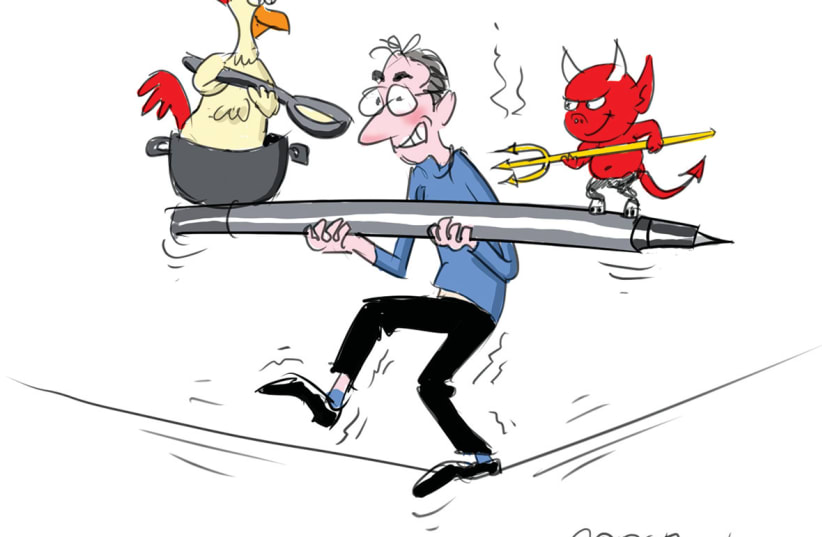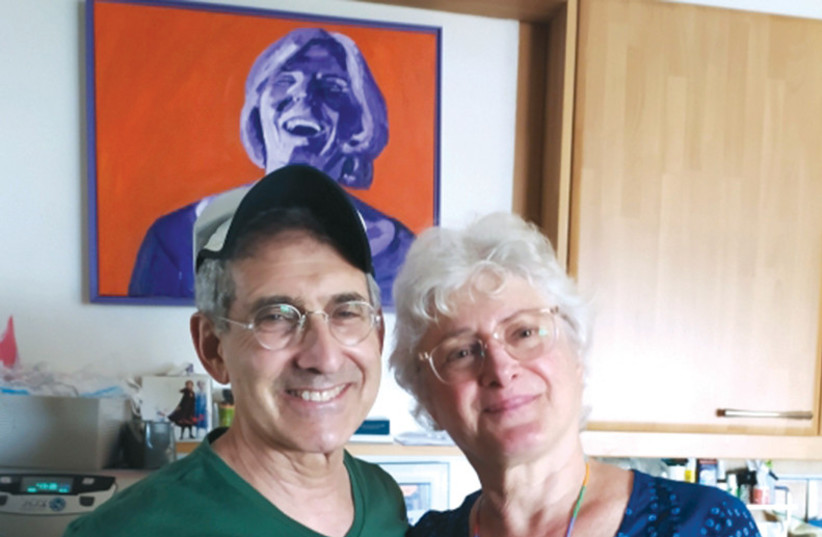“When I do a Jewish cartoon, I always feel like I’m on a tightrope,” says American cartoonist Dick Codor.
“On one side of my pen is chicken soup and on the other end a little devil.”
Then Codor lets us in on who he really is – a Jewish humorist.
The Jewish comedy cartoons of Dick Codor
“If I go too far with the chicken, the drawing turns into schmaltz,” he says. “Too much devil and the cartoon ends up just nasty. The objective is to strike the right balance while keeping my sense of humor and nerves intact.”
Codor has always been concerned about the unique cartoon style that has come to be his trademark. When he began half a century ago, he studied the cartoons of the time and found, in his estimation, that they were mostly “deadpan drawings.” He tried to copy what the successful cartoonists were doing.
“In the end, I was confused and felt like I didn’t have a style of my own,“ he says.
So he found the elements of cartooning which would display his unique talents.
“My strength was in the expressions, the gestures and the poses of my characters. For me, it’s the body language that must tell the story and not just the words.”
My personal relationship with Codor and appreciation for his work developed after 1977 when my family and I made aliyah from the United States. We had met in Wilmington, Delaware, where I was the rabbi. When I became a freelancer in 1978, I sought him out. As the cartoonist for a weekly food column in The Jerusalem Post, he introduced me to one of the paper’s editors. The publication of my article on the “Sholem Aleichem Oil Field” in Oklahoma followed in 1978. He gave me a boost, as a result of which writing became my vocation.
Codor asks, “Is Jewish humor something you learn?”
His answer is: “Many Jews would say it is in their DNA. In fact, they probably think that it is one of the most important things that defines them and sets them apart.”
I have been a big fan of his, and I always enjoy listening to and learning from his wisdom.
“Irony, wordplay, anti-authoritarianism and self-deprecation have always been a part of Jewish humor,” he says.
“The snake handing the apple to Eve is – to my mind – the world’s first practical joke. I like to imagine that there were a few kibitzers in the crowd commenting on Moses as he descended Mt. Sinai. When Abraham told Sarah that she was going to have a baby in her 90s, she bowled over laughing, which is why she called her son, Yitzhak (“laughter”).
In 1980, Codor left Jerusalem – where he had worked for the Israel Television Authority – and returned to the US.
“I came to New York as a freelance cartoonist and storyboard artist. I worked for a wide variety of publishing and entertainment companies,” he recalls.
“On any day, I might do a single cartoon, a series of editorial drawings, illustrations for books, games, puzzles, advertising and storyboarding for animated shows and movies.”
The Jewish connection that lasted the longest for him was with Hadassah magazine.
“For 35 years, working with editor-in-chief Alan Tigay and the rest of the staff, I regularly contributed illustrations in many styles and techniques for articles, covers, posters and other projects. Most importantly it gave me a stage on which to show my kind of Jewish humor.”
Codor’s last cover was turned into a jigsaw puzzle for the readers of the magazine, and donors received the puzzle as a gift.
Then came his bestselling illustrated Haggadah, 100,000 copies of which are used on Passover in Jewish homes around the world.
His cartoon, Joyous Haggadah “grew out of our big noisy chaotic family Passovers and the Haggadah that we always used,” he says.
“We never got more than halfway through the Seder; it was so boring and the Haggadot had the dullest pictures. Why couldn’t the writing in the Haggadah be lively and the pictures exciting and humorous?”
So he decided to make his own cartoon Haggadah entertaining for kids of all ages. He says the parts that “most people seem to like” are the Four Children, the Israelite waiting for his matzah to bake, “and the little kid peeing on the cactus before crossing the parted sea.”
Codor is co-author with Rabbi Samuel Barth of All You Want to Know About Sabbath Services (Behrman House), as well as the author of Too Many Latkes; Joyous Haggadah; Babushkin’s Catalogue of Jewish Inventions – with Larry Bush; and Max the Demon vs. Entropy of Doom – with Assa Auerbach (His books are available in French, Chinese and Bengalese and are all on Amazon.)
Codor does his art from 9 to 5, but he also has to figure out if what he has drawn makes the point.
“Countless times I’ve spent days working on an idea until it is drawn and colored just the way I wanted it, but there is one more step I have to take before I can unleash it to the world,” he says. “I show it to my in-house art director, my wife, for her approval. However, she might also say, ‘It doesn’t look right’ and even worse, ‘I don’t get it!’...Crushing.”
He is a very perceptive husband: “My wife is the reason I’ve never had to drive a taxi for a living or be a greeter at Home Depot,” he says. “She gives me the backing to get up the next morning and get back to creating the next new best thing.”
Summing up his career, Codor quips: “Drawing Jewish humor is a way of life. I didn’t choose it. It chose me. Judaism can be grim. Jewish humor makes you grin.” ■

